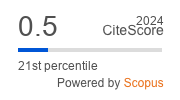MOLECULAR STUDIES OF DIROFILARIA IMMITIS AND DIROFILARIA REPENS PROVIDED WITH THE DIRECT PCR METHOD OF MOSQUITOES RESEARCH IN MOSCOW AND NIZHNY NOVGOROD REGIONS
Abstract
The aim of the study was to determine the degree of contamination of three kinds of female mosquitoes (Culex, Aedes, Anopheles) in some areas of Moscow and Nizhny Novgorod regions at different times of the warm season of the year (from May to September). Examined adult female mosquitoes collected in the Moscow and Nizhny Novgorod region in the summer of 2010 as potential vectors of Dirofilaria immitis and Dirofilaria repens. The presence of Dirofilaria spp. was detected by polymerase chain reaction using species-specific primers for D. immitis and D. repens. The index of Minimum Field Infection Rates (MFIR) was calculated.
It was founded that the MFIR ranged from 7 prob/1554 total mosquitoes (4,5) to 30 samples (19,3) of PCRpositive mosquitoes for D. immitis and D. repens, respectively. Dual infection with a D. Immitis, and D. repens was detected by PCR in 4 samples (2.6). The proximity of the area to Moscow increased the probability of detection of D. repens and in remote areas, on the contrary, was dominated by D. immitis. The highest rates of total infected mosquitoes were observed in early June and late August.
Concluded that the period of the most massive female mosquitoes infected from sick carnivores is at the beginning of August, the greatest risk of infection for healthy people and animals is in the late August — early September.
About the Author
V. M. RakovaRussian Federation
V.M. Rakova, PhD, minor researcher of the Institute of medical parasitology and tropical medicine named after E.I. Martsinovsky
References
1. Архипов И.А., Архипова Д.Р. Дирофиляриоз. — М., 2004.
2. Chellappah W.T., Chellappah G.R. Journal of Medical Entomology. — Vol. 5. — № 3. — 1968. — P. 358–361.
3. Anyanwu I.N., Agbede R.I., Ajanusi O.J. et al. The incrimination of Aedes (stegomyia) aegypti as the vector of dirofilaria repens in Nigeria // Vet. Parasitol. — 2000. — № 4. — P. 319–327.
4. Lee S.-E., Kim H.-C., Chong S.-T. et al. Molecular survey of Dirofilaria immitis and Dirofilaria repens by direct PCR for wild caught mosquitoes in the Republic of Korea // Vet. Parasitol. — 2007. — № 148. — P. 149–155.
5. Гузеева М.В. Роль и место редких гельминтозов в паразитарной патологии России: автореферат диссертации, канд. мед. наук. — М., 2009.
6. Архипов И.А., Борзунов Е.Н., Шайкин В.И. — 2001. W. Tarello. — 2000.
7. Ястреб В.Б. Эпизоотологическая ситуация по дирофиляриозу собак в Московском регионе // Российский паразитологический журнал. — 2008. — № 3.
8. Гуцевич А.В. и др. Насекомые двукрылые. Комары. Фауна СССР. 100. — Л., 1970.
9. Lee S.-E., Song K.-H., Liu J. et. al. Comparison of the Acid-phosphatase Staining and Polimerase Chain Reaction for detection of Dirofilaria repens infection in Dogs in Korea // J. Vet. Med. Sc. — 2004. — Vol. 66(9). — P. 1087–1089.
10. Murata K., Yanai T. Agatsuma T. et. al. Dirofilaria immittis Infection of a Snow Leopard (Unica Unica) in a Japanese ZOO with Mitohondrial DNA Analysis // J. Med. Sc. — 2003. — Vol. 65(8). — P. 945–947.
11. Song K.H., Lee S.-E., Hayasaki M. et al. Seroprevalence of canine dirofilariosis in South Korea // Vet. Parasitol. — 2003. — Vol. 114. — P. 231–236.






































